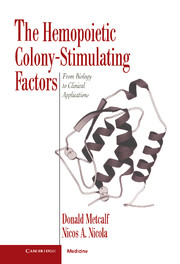Book contents
- Frontmatter
- Contents
- Preface
- 1 Historical introduction
- 2 General introduction to hemopoiesis
- 3 Key techniques in analyzing hemopoiesis
- 4 Biochemistry of the colony-stimulating factors
- 5 Biochemistry of the colony-stimulating factor receptors
- 6 Molecular genetics of the colony-stimulating factors and their receptors
- 7 Biological actions of the colony-stimulating factors in vitro
- 8 The biology of colony-stimulating factor production, degradation, and clearance
- 9 Actions of the colony-stimulating factors in vivo
- 10 Role of the colony-stimulating factors in basal hemopoiesis
- 11 Actions of the colony-stimulating factors in resistance to infections
- 12 Role of the colony-stimulating factors in other disease states
- 13 The colony-stimulating factors and myeloid leukemia
- 14 Clinical uses of the colony-stimulating factors
- 15 Conclusions
- References
- Index
4 - Biochemistry of the colony-stimulating factors
Published online by Cambridge University Press: 04 August 2010
- Frontmatter
- Contents
- Preface
- 1 Historical introduction
- 2 General introduction to hemopoiesis
- 3 Key techniques in analyzing hemopoiesis
- 4 Biochemistry of the colony-stimulating factors
- 5 Biochemistry of the colony-stimulating factor receptors
- 6 Molecular genetics of the colony-stimulating factors and their receptors
- 7 Biological actions of the colony-stimulating factors in vitro
- 8 The biology of colony-stimulating factor production, degradation, and clearance
- 9 Actions of the colony-stimulating factors in vivo
- 10 Role of the colony-stimulating factors in basal hemopoiesis
- 11 Actions of the colony-stimulating factors in resistance to infections
- 12 Role of the colony-stimulating factors in other disease states
- 13 The colony-stimulating factors and myeloid leukemia
- 14 Clinical uses of the colony-stimulating factors
- 15 Conclusions
- References
- Index
Summary
The colony-stimulating factors were originally described as biological activities in crude cell-conditioned media. Their intrinsic stability was a great advantage in their analysis and purification, but their heterogeneity, due primarily to differential glycosylation, and their extremely low concentration ensured that the purification of the CSFs would be extremely difficult and take up the better part of a decade. Even then, insufficient amounts of the CSFs were available from natural sources to allow detailed structural analysis and studies in vivo of their biological activities. With the advent of recombinant CSFs produced in Escherichia coli, it became apparent that glycosylation was not essential either for correct structure formation or for biological activity. This made it possible to perform detailed structural analyses of the CSFs as well as animal and clinical studies. The CSFs are all glycoproteins (Table 4.1), and despite having very little primary amino acid sequence homology, they have very similar folder structures; their stability and solubility are maintained by internal disulfide bonds (and intersubunit disulfide bonds in the case of M-CSF) and attached carbohydrate chains. In this chapter the purification, structural analysis, and structure-function studies of the CSFs will be described.
GM-CSF
The major CSF activity in medium conditioned by lung tissue from endotoxin-injected mice was recognized to have distinctive biological and biochemical properties (Sheridan and Metcalf, 1973a). This CSF was termed GM-CSF and was purified to apparent homogeneity by Burgess et al. (1977) using a combination of ammonium sulfate precipitation, ion-exchange chromatography, binding to concanavalin A-Sepharose, and gel filtration.
- Type
- Chapter
- Information
- The Hemopoietic Colony-stimulating FactorsFrom Biology to Clinical Applications, pp. 44 - 64Publisher: Cambridge University PressPrint publication year: 1995
- 1
- Cited by



